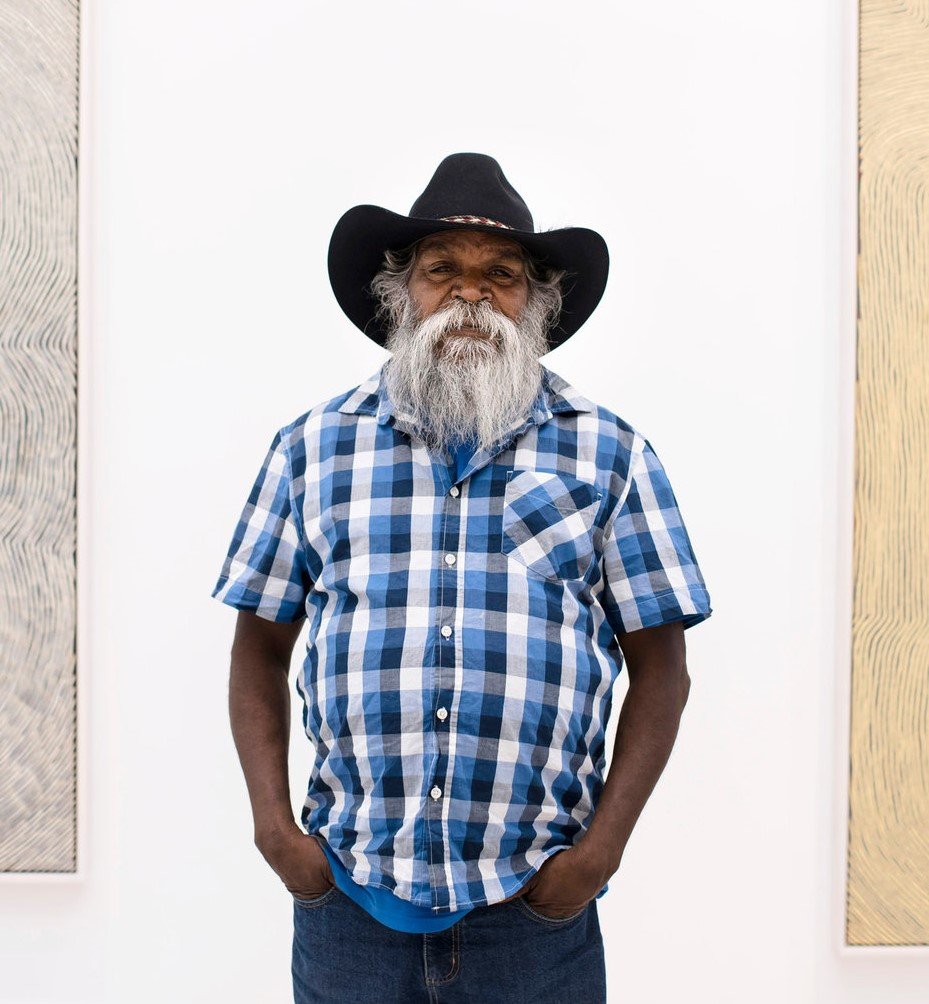WARLIMPIRRNGA TJAPALTJARRI
MARKET ANALYSIS

Photo: Karsten Moran for The New York Times
Having walked in from the Great Sandy Desert in 1984 Warlimpirrnga spent a number of years observing other artists at work prior to creating his first painting in 1987. He has worked exclusively for Papunya Tula other than for a sustained period during the mid to late 1990’s and during infrequent visit to Alice Springs where he has developed relationships with several reputable dealers. It is unsurprising therefore that 8 out of his top 10 results have been for works created for Papunya Tula. These include his 4 highest results at auction, he only exceptions being two Tingari images including his 5th and 8th highest sales of which the lower result is by far the most distinctive and pleasing. This was created for Alice Springs art dealer Linx McPherson. Interestingly only 1 work amongst these highest results, an accomplished pleasingly coloured formal 1991 Tingari painting, was created prior to 1999 and, if fact, the earliest work that has appeared for sale was created in 1989. This seems surprising given that he painted many fine works while working with Gallery Gondwana during the mid to late 1990’s despite the fact that few are yet to appear in the salerooms.
Unfortunately, despite an auction record of $48,000 set for Maw Maw Yntjipi at Sotheby’s in July 2006 (Lot 119) Warlimpirrnga’s career clearance rate is a very disappointing 42%. It is unusual that an artist with as many as 50 sales records and such a low success rate should have just 1 work reoffered, and the story did not have a happy ending. Untitled (Tjuntulpul) 1999, a work with Papunya Tula provenance measuring 122 x 122 cm. sold for $5,700 at Sotheby’s in July 2003 (Lot114). In that sale two works were sold as consecutive lots (113 and 114) and set the artist’s record and second highest results ever recorded. Despite the fact that when Sotheby reoffered it’s in October 2006 it was still the 4th highest record, it failed to attract a buyer.
Warlimpirrnga’s highest grossing year at auction was 2006 when 8 works were offered of which 4 sold for a total of $85,835 and it is his results since the beginning of that year that are probably provide the most reliable guide for those comparing his prices with the cost of purchase through a gallery or Papunya Tula as 7 of his 10 highest results have been set since then. Of the 22 paintings that have appeared between the beginning of 2006 and the end of 2008 only 8 have sold for a total of $127,167 and an average of $15,896.This includes the artist’s 3 highest results, all achieved for Papunya Tula works measuring approximately 183 x 152 cm which have sold for an average of $30,733.
As would be expected Sotheby’s have been most prominent amongst the houses offering his works having been successful with 9 at an average per work of $10,338 while Lawson~Menzies have sold 5 at an average of just $4,171. No other auction house has sold more than 3.
In summary, while Warlimpirrnga is an important artist he is but one of a number of Papunya artists who have developed a relatively generic op-art-like style. While finest works feature meticulously applied designs that exhibit a distinct rhythmic quality many others lack distinction. In recent years so many Pintupi men have returned in their painting to the zig zag designs and parallel lines that mimic the fluting incised on their traditional ceremonial objects and weapons. While they seem to be looking backward their counterparts in the Western Pitjantjatjarra lands across the tri-state boarder seem to have been far more adventurous. While their works appear to be fresh and bold, Papunya men’s paintings, by comparison, seem accomplished but formulaic. Having expressed this opinion, it is nonetheless true that Warlimpirrnga’s best works will always be worth adding to any fine collection. Seek out works distinguished by the fluidity of the line work and subtle colour variation. It seems to me that these will ultimately prove the most engaging and satisfying.
© Adrian Newstead

